





This article is part of the special season start. All parts:
- Cast off - how to get the new season off to a smooth start
- Checklist: Fit for the new season - the checklist
- Cleaning, polishing and care
- The best care and cleaning products for boats
- Last-minute tips from the experts at Pantaenius for the start of spring
- Checklist for the boat trailer
- The best tips from the Pantaenius specialist
- Changing the oil in a boat engine - here's how!
- Special pumps - changing oil in no time at all
- To check the cooling circuit
- How to renew the antifouling
- Boat equipment - the more, the better
In this article:
As the crane date approaches, the important tasks such as maintenance, repairs and planned conversions or modifications must be carried out first. Cleaning the boat is usually further down the to-do list, but is urgently needed after the winter work. Sanding dust and hall dirt from shoes are scattered around the boat. Making the boat beautiful for the season not only has aesthetic benefits, cleaning every last corner can also reveal damage that might otherwise have gone unnoticed. The maintenance also helps to preserve the value of the boat.
Spring cleaning may also be on the agenda at home, but there are a few things to consider on board that require special care or where conventional products can even be harmful. The teak deck, for example, does not tolerate strong cleaning agents and abrasive sponges. The gelcoat is washed in the spring before polishing; no cleaning agents that attack the sealant should be used during the season. Unlike on land, the toilet has a pump with sensitive seals, so do not use strong cleaning agents here either. The upholstery is at risk of mould; this can be prevented with special systems for ventilating the underside of the mattress, regular heating and ventilation or a dehumidifier.
The right equipment for boat cleaning
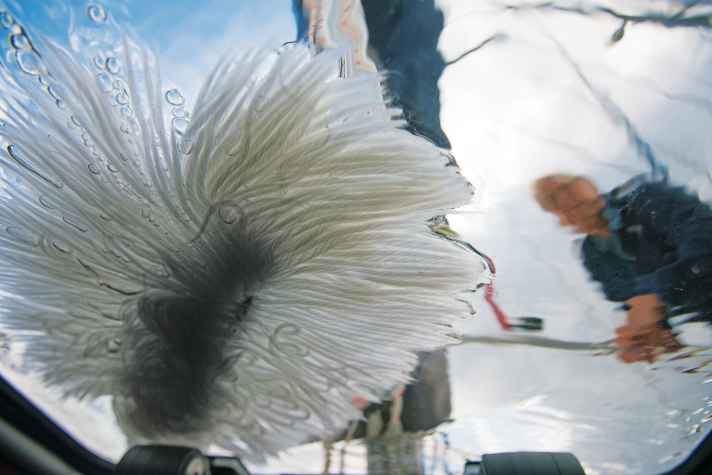
You don't need much in the way of special equipment. In addition to a cloth, sponge and brush (including one with a handle for washing the deck), kitchen paper is very useful when working on the engine and installation. It is hardly ever necessary to buy a high-pressure cleaner; there is usually one in the harbour at the crane.
In many cases, special cleaning sponges or Radiator spongesMagic-Cleaner or Plastering stones which are designed to work without additional cleaning agents. These are simply abrasives; cleaning is carried out by removing the dirty surface. These abrasive methods should be used very carefully on board, as the gelcoat and windows are sensitive. Microfibre cloths, on the other hand, can be useful helpers. Thanks to their special surface properties, they absorb dirt particles particularly well. Smooth surfaces should therefore only be cleaned with water and a cloth of this type.
We provide an overview of the right choice from the multitude of different cleaning agents, taking into account the different materials on a boat
As with all work on the boat, make sure you wear suitable protective equipment when cleaning. Gloves should be worn, especially when handling acidic cleaners or the wood preservative Boracol.
When your own boat sparkles after a thorough spring clean, nothing stands in the way of a relaxed start to the new season!
Wipe

The cloth can be used to gently clean surfaces. Microfibre cloths have a cleaning effect due to their structure
Scrubbing

A Rinsing sponge can do a good job, but be careful with the rough side: it can dull shiny surfaces.
Brushes

One Brush penetrates with its bristles even into small irregularities. This allows an anti-slip structure or the inflatable boat to be cleaned.
Clean hull, deck & underwater area

TheHigh pressure cleaner is ideal for removing coarse dirt and vegetation. It is usually used in autumn; if necessary, repeat the work in spring.
Deck

Algae, moss, mould: the teak deck quickly turns green, especially in corners. It dries more poorly in these areas and the wood is attacked. The tried and tested wood preservative Boracol removes the growth. One preventative treatment is enough for the season. Highly recommended!
Waterline

Limescale deposits and dirt form yellowish deposits, especially at the water pass. Antigilb contains oxalic acid, which dissolves the limescale. Apply, leave to work and then rinse off with water and a sponge. Antigilb is available from various suppliers
Drive

Scrape the pockmarks off the propeller with a spatula. Remove the hard-to-remove residues with Citric acid loosen. To do this, place the dismantled prop in a container with the acid or, if it is to remain on the shaft, wrap it with acid-soaked cloths/diapers and leave it to work
Hull

Boatshampoos are available from various manufacturers. What they all have in common is that they are very mild cleaning agents. This means that the polished and sealed gelcoat can also be cleaned without destroying the protective layer. This means there is no need to reseal after cleaning
Metal
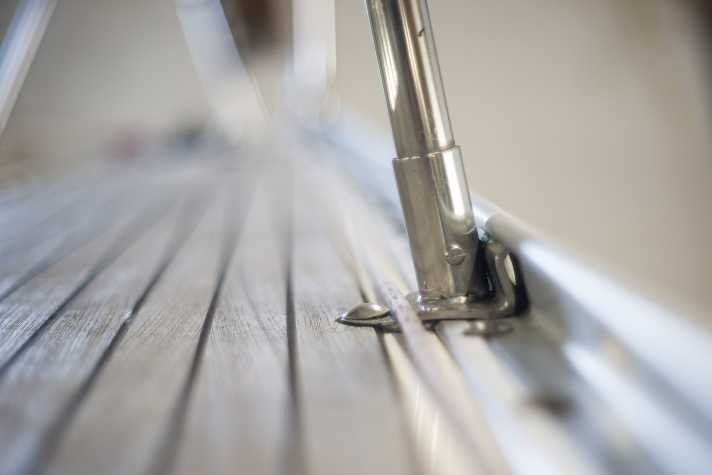
The saltier the water, the faster traces of rust form - even on stainless steel surfaces. The bow and stern pulpit and railing supports can be polished and preserved with the special agent Flitz. The matt film can be polished to a high gloss after drying
Foil window
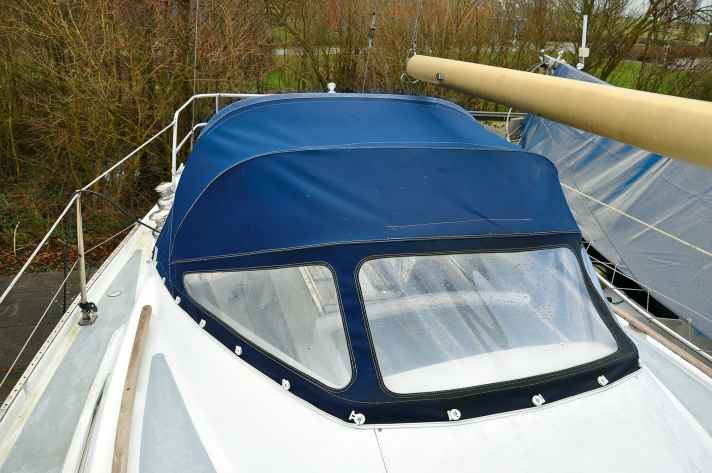
Vuplex can be used to polish and seal the film windows in the sprayhood and cake stand. The spray fills small scratches, making the windows clearer, and creates a layer from which water and dirt simply roll off. Has proven itself in practice
PVC fabric
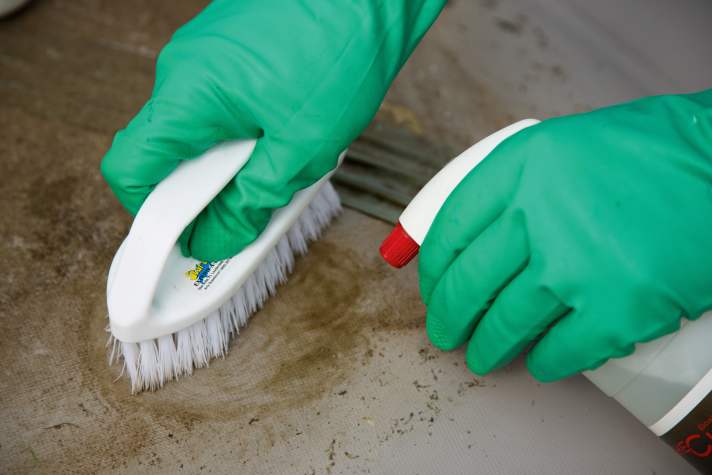
Inflatable boats and fenders are exposed to a lot of stress and can quickly become very dirty. In the test of inflatable boat cleaners carried out by our sister magazine YACHT (YACHT 12/14), The Cleaner did this job best. For heavy soiling, a brush helps as a reinforcement
Plastic
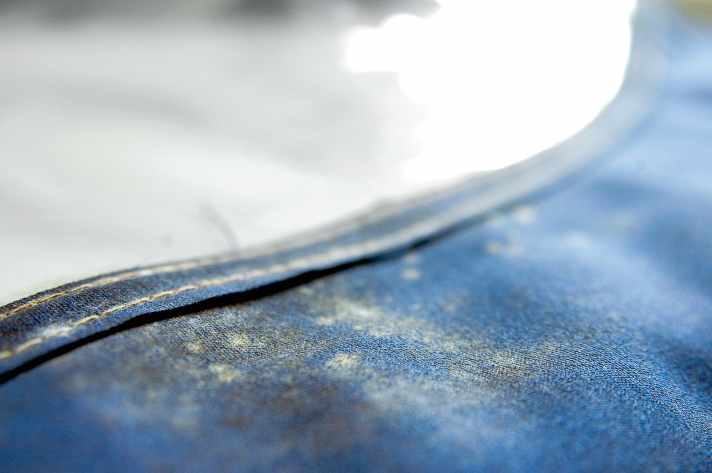
Spak and mould stains on plastic surfaces can be easily removed with Klorix can be removed. The cleaning agent is not recommended for tarpaulins as it contains bleaching agents that can lead to discolouration. It is better to use soapy water and a brush
Bilge
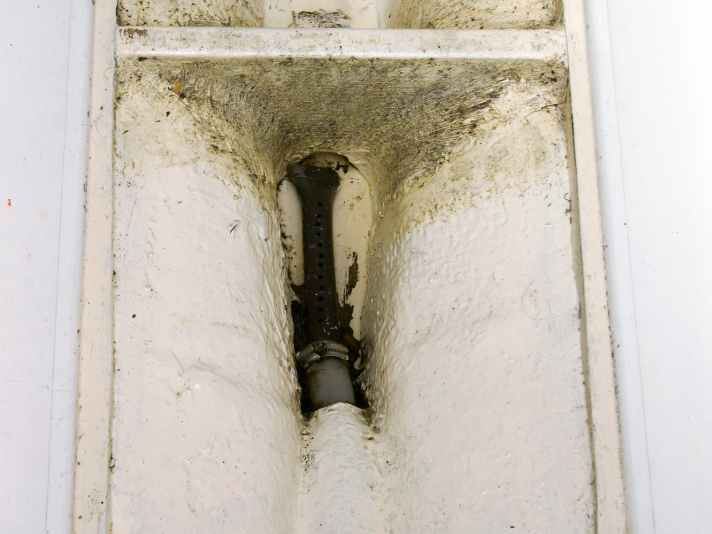
The dirtiest corners on board are in the bilge. Why clean there? To detect leaks and leaks in the engine or to find lost small parts. There are special bilge cleaners for this purpose. If there is engine oil in the wash water, dispose of it correctly
Below deck
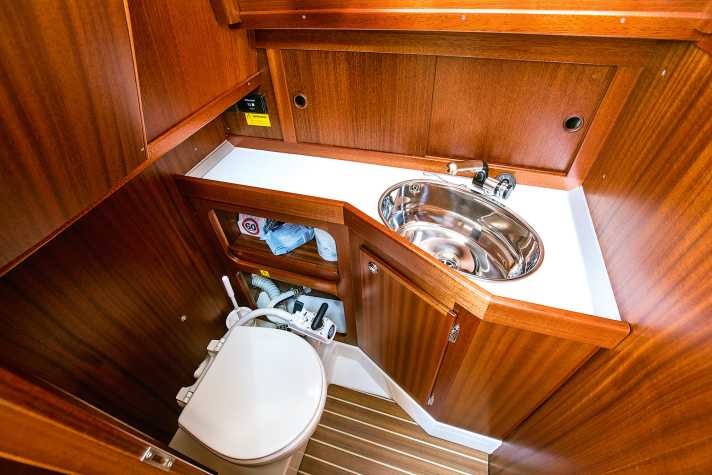
In the cabin, is the boat no different from the four walls at home? Wrong! The toilet, for example, requires different cleaners!
Toilet
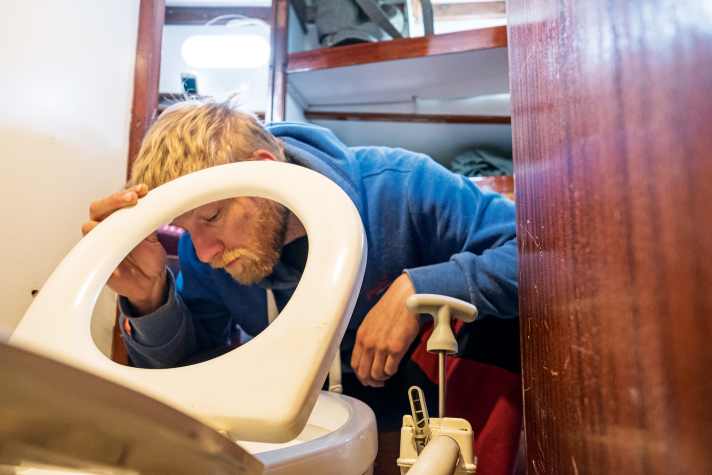
The seals in the pump of the on-board toilet are made of neoprene. The plastic does not tolerate strong cleaning agents, so only use washing-up liquid or citric acid instead of toilet duck to prevent limescale build-up. This will keep the seals intact and the toilet will continue to work
Wet room
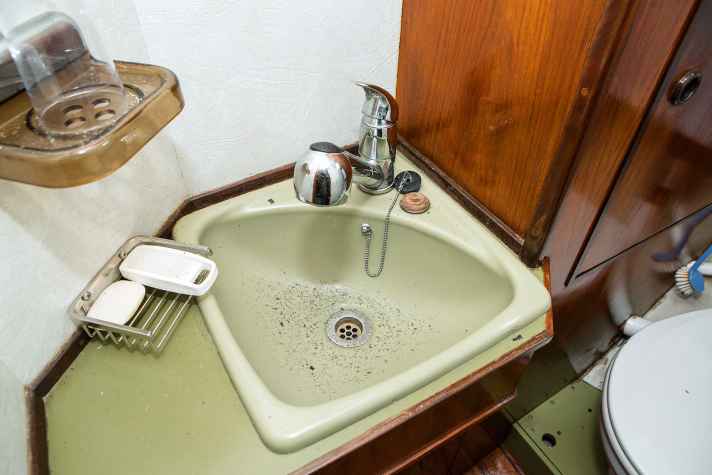
Washbasins, sinks and worktops can be cleaned with scouring milk. Subsequently, sealing with the spray agent prevents Vuplex the renewed soiling. This also works very well on joints made of sealant and the walls in the shower
Tank
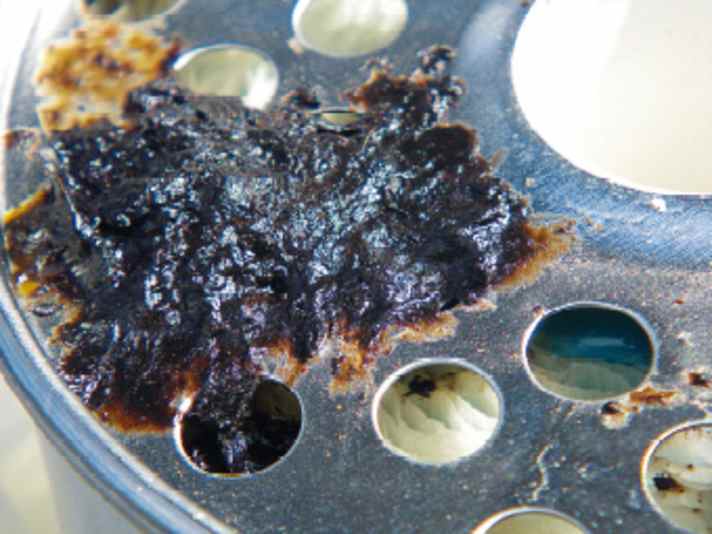
Grotamar or biocide-free enzyme-based variants such as Xbee protect the diesel fuel from bacterial growth. However, if it is already too late, the only solution is to remove the sludge from the tank by hand. The best way to do this is with a scraper through a maintenance hatch.
Textiles
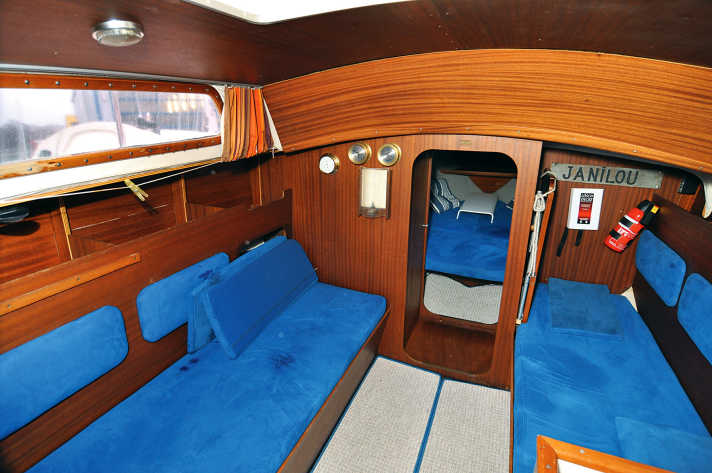
Special cleaning agents for upholstery and fabrics are particularly mild and contain no acids to prevent discolouration. Spray evenly and then wipe or vacuum. If cushion and upholstery covers are removable, they can also be washed in the washing machine.
Surfaces
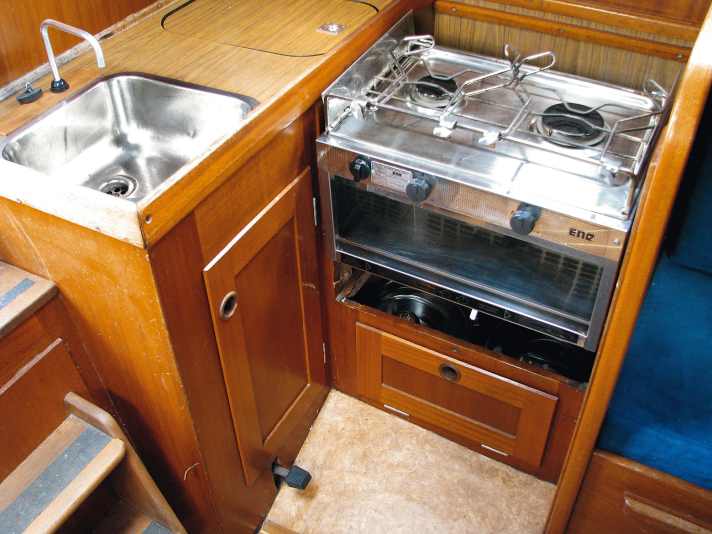
Smooth surfaces in the pantry, such as the hob and worktop, as well as clear lacquered wood, can be cleaned of grease splashes with window cleaner. For windows made of acrylic glass, check beforehand whether the cleaner is suitable. Do not clean with the rough side of the sponge
Mould on the boat
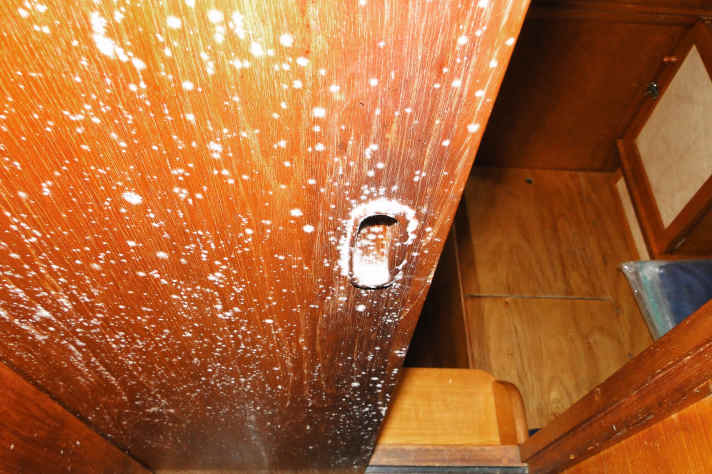
Mould is a common problem on board. It thrives particularly well in a damp environment. Mould removers usually only help in the short term. To prevent mould growth, the relative humidity should not exceed 60 percent. The warmer the air, the more water it can absorb. As a result, the relative humidity changes with the temperature. The value is given as a percentage; at 100 per cent, the air is completely saturated. If the air is heated, the relative humidity decreases. If, on the other hand, the temperature drops when the air is completely saturated, water condenses and can no longer be bound in the air. This effect causes moisture on the inside of the side wall, for example. Especially in cold outside temperatures, there is a risk of getting wet inside the boat. Heating or a Dehumidifier.
Downloads:
This article is part of the special season start. All parts:
- Cast off - how to get the new season off to a smooth start
- Checklist: Fit for the new season - the checklist
- Cleaning, polishing and care
- The best care and cleaning products for boats
- Last-minute tips from the experts at Pantaenius for the start of spring
- Checklist for the boat trailer
- The best tips from the Pantaenius specialist
- Changing the oil in a boat engine - here's how!
- Special pumps - changing oil in no time at all
- To check the cooling circuit
- How to renew the antifouling
- Boat equipment - the more, the better

